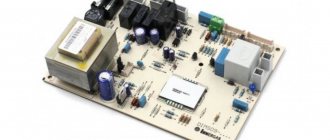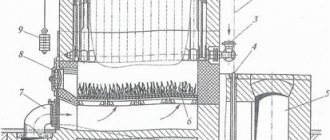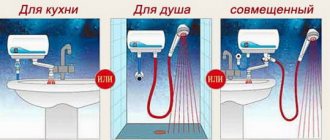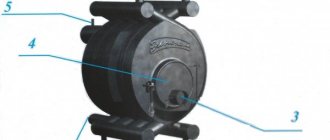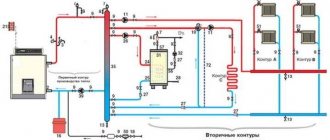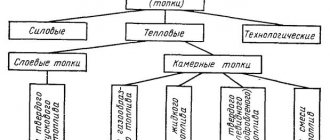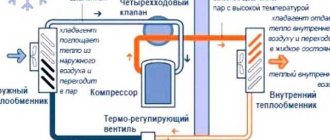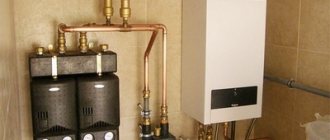Pros and cons of using a burner for heating
A gas burner is a device that, by mixing air with natural or liquefied gas and supplying the mixture to the outlet, forms a torch and distributes the flame. It ensures efficient combustion of fuel and regulation of the combustion process.
Advantages of using gas burners for heating stoves:
- Ease of use. Gas burners greatly simplify the process of heating furnaces, eliminating the need to prepare solid fuel and constantly maintain combustion.
- Controllability of the heating process. Simple models, without automation, need to be turned off independently as soon as the temperature reaches the required level, leaving only the wick lit. Burners with a control panel make life much easier by more accurately setting the temperature.
- Security. Automatic nozzles have overheating protection functions and turn off the gas supply in case of poor draft or lack of flame.
- Minimal contamination of the chimney duct. A scheduled inspection of the chimney is carried out once a year, mainly for prevention - little soot is formed from the combustion of gases.
The transition from solid fuel equipment to heating with gas burners greatly simplifies life, freeing up a lot of time for more interesting and useful activities.
Gas burners are intended for heating private houses, baths, industrial buildings - the purpose must be taken into account when choosing the type of equipment
The main disadvantage of converting a stove by installing a gas block is that the energy efficiency is not very high. High fuel consumption is especially noticeable if the gas heating system in a country house is designed by an amateur.
In addition, it is not always possible to obtain permission to install a gas burner - if the stove is outdated, the chimney is of incorrect design, or the room parameters do not meet fire safety standards.
What is a gas burner?
Gas burners for boilers are structures within which gas and oxygen are mixed. The mixture flows to the outlet holes and there ignition occurs from a spark or piezoelectric element and a stable, stable torch is formed.
The main task of the listed elements in boilers is to maintain stable and constant combustion of the resulting mixture. As you can see, the design of the boiler with a gas burner is quite simple and its installation will not cause difficulties.
A gas burner consists of several components: a nozzle, an ignition system, an automation system and a flame presence sensor.
Its structure must, first of all, be safe. In addition, this element of the heating boiler must burn the mixture without residue, and the release of harmful substances must be minimal.
Low noise level is another requirement for devices. You definitely need to pay attention to the service life.
Gas burners for heating boilers with automation are another safety requirement. As soon as the fire goes out, the fuel supply automatically stops. This is one of the main criteria for her selection.
They have found their application in household heating colas and in industry. Gas, despite its high consumer qualities, has a fairly low cost compared to other types of fuel. This makes gas burners in demand and popular.
Atmospheric gas burner.
Today, gas AOGV boilers - gas heating water heating devices - are of great interest. A distinctive feature here is the energy dependence of the boilers, that is, they can operate without an electrical network.
In addition, the noted devices are fully automated by the automated control system, which plays the role of an automatic temperature regulator and reduces the amount of fuel consumed.
Selection of burners for different types and models of boilers
When choosing a burner, you should pay attention to its various characteristics - the fuel supply model, the option of mixing gas with air, compatibility with various categories of devices. We will tell you about the most interesting models.
- KChM burner. It is used in boiler units converted from conventional fuel to LNG or conventional gas. It usually has automation and has three nozzles. It is used in boiler units of the “Contour” model or similar options.
- Burner "Hearth". It is a pneumomechanical type device with an automatic operating mode. It turns off on its own if:
- the fire went out;
- gas supply stopped;
- there is no necessary traction.
This model has a gas pressure controller. This makes it possible to achieve equal burning of the fire, even if any malfunction occurs in the mechanism. Such solutions are easy to maintain due to the fact that soot does not accumulate in the convective part.
- Another burner that I would like to talk about is the “Kupper” . This option is universal and is suitable for combined boilers, solid fuel designs from Kiturami or Russian-made models of the Conord brand. The advantage of this burner will also be the ability to install it without plumbing or welding.
- Another fairly popular solution is a burner for DKVR . This block device is used where there is forced air supply. This solution is used for steam boilers for industrial use and having the appropriate power. Their efficiency is about 94-95 percent. A similar design works either in a diffusion or in an inflatable version. To increase its efficiency, powerful Italian fans are often used.
- Another category is burners for KVS . They are used for domestic needs and are solid fuel. Considering that there is no need to use overly powerful equipment to heat rooms, atmospheric or injection solutions are used. When selecting a burner element, you should pay attention to power and safety in use.
Selection rules
The gas burner must be selected according to the size of the nozzles - for natural or bottled gas.
When choosing the appropriate type of gas burner, the main attention is paid to its technical characteristics:
- nozzle dimensions;
- fuel supply method;
- a method of mixing gas with oxygen and regulating the composition of the mixture;
- compatibility with other boiler models;
- the presence of automation that controls the operation of the burner.
Among the noteworthy models are products of the KChM brand, widely used in modernized boiler units. They have three nozzles, controlled by automation, and are usually installed in Kontur type boilers.
When selecting a reliable and easy-to-maintain gas burner for heating boilers with automation, attention is also paid to its ignition device. The latter should occur without popping or similar extraneous sounds. The design of the combustion chamber significantly influences the noise level during ignition. In the process of assessing the reliability of the selected model, attention is paid to the degree of safety of using the device.
With or without an injector: how does it work?
There are two types of gas burners. Let's look at each of them in detail.
Burners without injector
Design of injection and non-injector burners.
These gas burners operate at high pressure, have a relatively simple design and are extremely efficient to use.
Here is the algorithm in which they operate:
- The necessary oxygen is supplied from the air through special rubber slots and a valve, after which it enters the mixer.
- The function of the mixer is to divide the total flow into small jets that enter the nozzle. In the same way, the flow enters a special valve.
- Mixing of gas with oxygen occurs through circulation to ensure that the output is as homogeneous as possible.
- The mouthpiece at the tip is usually made of durable metal, such as copper. The mixture, heated to a very high temperature, comes out through it. The outlet temperature will be even higher than the melting point of metals.
An additional requirement applies to the mixture: it must burn completely. The speed of the gas flow must be sufficient to prevent the flame from spreading to the top of the device, which is very, very dangerous due to the high risk of explosion.
On the other hand, the speed of the hot gas flow should not be too high due to the risk of the flame detaching from the mouthpiece with its subsequent attenuation.
How to calculate the optimal gas flow exit speed?
There are several factors to consider:
- composition of the combustible mixture;
- diameter of the inner wall of the nozzle;
- technical device of the mouthpiece.
The average speed is in the range of 70 – 150 m/sec.
Burners with injector
Methane, oxygen or acetylene are used as combustible gases, which are pumped into the mixer using an injector. This is the technological feature of the injection family of welding torches.
Here's how the injector design works:
- Combustible gas is pumped into the mixing chamber by an injector.
- Oxygen comes from the cylinder there too.
- After entering the mixer, the gas is mixed with oxygen in the air.
- The resulting mixture flows through the pipe into the mouthpiece.
- The gas pressure from the mouthpiece must be at least 3.5 atmospheres.
Such gas burners are used very widely, despite the low pressure and rather complex design. They have a built-in cooling system, since due to the low pressure the nozzle and mouthpiece become very hot. Therefore, the most important point is to control the overheating of the chamber so that it does not explode.
Atmospheric burners
A burner of this type sucks in air according to the principle of a jet pump: gas is passed through an ejector, where, due to the high speed of movement, its pressure drops (Bernoulli’s law); air is sucked into the gas flow due to the pressure difference. The strengths of this device include the following:
- Simplicity of design.
- Compactness.
- Energy independence.
- Low noise level.
- Low cost.
- Possibility of simple conversion of a solid fuel boiler to use gas fuel: the atmospheric burner just needs to be installed in the ash pan chamber.
The principle of operation of an atmospheric burner
However, it is impossible to “load” too much air into the gas flow only due to the jet effect, therefore burners with high power cannot be atmospheric.
The power limit for atmospheric burners is on average 9 kW (approximate value of the maximum heated area is 90 sq. m).
Homemade units
There are craftsmen who remake heating systems with their own hands. On the Internet you can even find the necessary diagrams for changing the devices of gas burners, their installation and adjustment.
Typically, metal is used as a material for the manufacture of heating systems. A cast iron firebox would be much more reliable. However, it is not possible to use it at home.
An excellent option for manual work is to order the system from specialists. They will be able to manufacture the device in accordance with all the customer’s wishes. However, the possibility of defects in the boilers cannot be ruled out, which may appear after some time.
Why do you need homemade heating units? The fact is that the marked options have a lower cost. They are made mainly because of the desire to save money. At the same time, these options are inferior to their factory counterparts in efficiency.
Over a long period of operation, it may turn out that the homemade option will be even more expensive.
Usually only solid fuel and electric units are manufactured. Making a gas or diesel boiler is extremely dangerous. In addition, their installation in the house is strictly prohibited.
According to the principle of operation, a homemade product is no different from a purchased version. It will burn fuel and heat the coolant filled with water.
The main disadvantage of this unit is the lack of warranty. Factory equipment will work and perform its functions. Even if the buyer stumbles upon a defect, he will be able to exchange the product for another.
It is better to use pellets, firewood, and coal as fuel in self-made units. These materials are less dangerous than gas. It is impossible to make heating devices based on the latter.
Simple solid fuel units are the most popular and widespread homemade devices. They are simple, and their design is in many ways similar to a conventional stove. In addition, they are versatile.
Like a conventional stove, these systems can operate on any solid fuel. The main thing is that it burns.
Main parts of a gas boiler.
The efficiency of homemade equipment is significantly lower than factory equipment. It is influenced by many factors.
Among them:
- thermal insulation;
- combustion completeness;
- the correctness of the conclusions.
The efficiency of the unit directly depends on the combustion temperature. The higher it is, the lower the efficiency. In high-quality systems, the temperature in the firebox is maintained at 120–150°C. Higher values reduce the safety of pipes. This in turn significantly reduces the durability of the unit.
When manufacturing heating boilers with a burner, it is better to protect yourself as much as possible from the possible consequences of its operation. Therefore, you should consider a separate purchase of an automatic gas burner, which will be installed in an atmospheric or blown boiler.
You can also make electric heating units with your own hands. Their design may vary. It all depends on the person’s needs. The simplest option is to install a heating element directly into the heating system. In this case, there is no need to make a boiler.
The pipe with the heater must have a sufficiently large diameter. It should be easily removable for repairs and cleaning.
Systems without a heater deserve special attention. Its role is played by water itself. A current is passed through it, and heating occurs due to the movement of water ions. The liquid itself must contain salt.
One of the dangers of this device is electrical breakdown. Essentially the same as a short circuit. Gas may also accumulate in the system. As a result, heating efficiency will decrease.
From all of the above, the best option is a solid fuel unit. Its body can be assembled from heat-resistant steel. It is characterized by increased strength, less wear and high resistance to thermal influences.
However, heat-resistant steel is expensive and in practice is rarely used in homemade boilers. Another option is cast iron: this material tolerates heat well, although it is difficult to work with. Equipment for the manufacture of cast iron stoves is available only at specialized enterprises.
It is important to understand that without the proper experience and skills, it is better not to make a heating system yourself. Safety must come first. It is enough to make even one inaccuracy, and this can lead to disastrous consequences.
Safety rules when using burners
Failure to comply with precautions when installing and using gas burners for heating premises can lead to emergency situations and accidents: fire in the house, carbon monoxide poisoning.
When operating gas equipment, you should adhere to the following rules:
- Observe the service life. The burner's service life, depending on the model, can range from 8 to 15 years. Then it must be replaced.
- Use models with a function that automatically turns off the device in the absence of draft or flame.
- A stove equipped with gas burner units must meet safety requirements.
The design, installation or repair of a gas burner must be carried out by certified gas service workers, with whom an agreement has been concluded for the supply of fuel and maintenance of the units.
If possible, it is still necessary to use gas boilers or special furnaces that are designed to work with natural or liquefied gas
To obtain permission to install and connect to the main gas network, a number of conditions must be met:
- compliance with the rules for connecting a gas burner;
- appropriate design of the smoke channel, its high-quality insulation;
- installing a spark arrester at the top of the chimney.
This is the minimum requirement for installing forced-air gas burners.
For atmospheric there are additional requirements:
- presence of adjustable traction;
- ensuring good ventilation;
- the volume of the room in which the gas burner is installed is from 12 m3.
If equipment is converted to use liquefied gas, it is necessary to ensure safe storage of the gas cylinder. This can be a separate room or a metal cabinet. If you plan to store gas reserves in a gas tank, then the tank is installed underground at a distance of no closer than 5 m from the building.
DIY gas burner
So, let's look at how to make gas burners for heating boilers with your own hands. A homemade gas burner for a solid fuel boiler can be assembled based on a valve from an oxygen cylinder, for example, VK-74. Its outlet pipe should be equipped with a homemade fitting, which can be connected to the gearbox using a rubber-fabric hose.
On the inlet pipe intended for screwing into the cylinder, you need to install a cap with a hole for connecting the nozzle. The latter can be borrowed from a gas stove or blowtorch.
It is necessary to weld a nozzle to the cap - a piece of steel pipe 100 mm long, the wall thickness of which is 2 mm.
There should be a gap of 15 mm between the cap and the nozzle, through which air will be drawn in, so first you need to weld three pieces of thick wire to the cap, and then a nozzle pipe to them.
The homemade burner is ignited in three steps:
- We open the tap on the gas supply line or on the cylinder (in the case of using liquefied gas).
- We bring a match, a lighter or a burning paper wick to the nozzle.
- Open the valve.
The power of this device can be adjusted by closing or opening the valve. The green-blue part of the flame is the hottest.
The nozzle setting is to position the torch in its center. To do this, the wire holders are slightly bent.
If the burner is needed for operation, a tip bent at an angle of 45 degrees should be welded to its nozzle.
A steel cylinder valve can also serve as the basis for a homemade gas burner. A plug with a hole made in it for the nozzle is screwed onto its pipe. In this case, the “donor” of the jet is a blowtorch, the nozzle of which has a diameter of 0.8 mm. The nozzle of the burner itself should have a diameter of 30 mm. By changing its length using attachments, you can adjust the size of the torch. A valve can play the role of a regulator.
Installation of a gas burner in a heating furnace
We remind you that it is prohibited to install gas equipment yourself. However, it won’t hurt to familiarize yourself with the nuances of installing a gas burner in a stove.
So, installation of a gas burner is permissible in furnaces in which the length, shape, nature and temperature of the flame can be adapted to the nature of the material of the combustion chamber. The flame should not touch the walls, but should be freely located in the combustion space. If it is a brick wall, then the firebox should be made of refractory bricks.
Before installation, check the walls of the stove for cracks, voids, and unsealed seams through which combustion products can enter the room. The room into which the firebox door opens must have an opening window, a ventilation duct and a gap in the door for air to enter from below.
Gas burners of any type are characterized by the creation of high temperatures - more than 1000 °C in the combustion chamber. When installing a gas burner in the oven, you must ensure that the flame does not touch the walls.
The installation process itself is not complicated and is carried out in the following sequence:
- Remove the firebox door.
- A burner is placed in the combustion chamber.
- The shield is secured in the door frame.
- Connect the automation according to the manufacturer's instructions.
At the end of installation, connect the burner to a hose, the other end of which is connected to a gas source.
Installing a burner using the example of an AGG gas burner device: the stage of installing a gas burner block in a furnace with dismantling the ash pan
The system is launched by a master from the gas service, he checks the operation of the nozzles, the automatic control and safety systems, configures and tests the response of the sensors.
Installation of a gas burner in an industrial furnace using the example of an AGG gas burner device. Connecting automation, placing the remote control and thermal cylinder
Another step is to check the tightness of all connections and the presence of traction. After successful startup of the system, the gas installer must issue a completed control certificate for the installation of the burner.
When starting the heating, you should first select the minimum thermal power, heating the stove continuously and little by little or, if there is no power adjustment, cyclically, turning the burner on and off. This is especially important for a brick kiln - strong continuous heating of a cooled brick can lead to cracking.
Build process
The process of creating a boiler includes several stages. When manufacturing each element, it is worth taking into account the special operating conditions of the product being manufactured.
Air supply device
We cut a section from a thick-walled pipe with a diameter of 100 mm, the length of which will be equal to the height of the firebox. We weld a bolt to the bottom. From a steel sheet we cut out a circle with the same diameter as the pipe or larger. We drill a hole in the circle large enough to pass the bolt welded to the pipe. We connect the circle and the air duct pipe by tightening the nut onto the bolt.
As a result, we will get an air supply pipe, the lower part of which can be closed by a freely moving metal circle. During operation, this will allow you to regulate the intensity of firewood combustion and, consequently, the temperature in the room.
Using a grinder and a metal disc, we make vertical slits approximately 10 mm thick in the pipe. Through them, air will flow into the combustion chamber.
Housing (firebox)
The body will require a cylinder with a sealed bottom with a diameter of 400 mm and a length of 1000 mm. The dimensions may be different, depending on the available free space, but sufficient for laying firewood. You can use a ready-made barrel or weld the bottom to a thick-walled steel cylinder.
Sometimes heating boilers are made from gas cylinders for a longer service life.
Chimney
In the upper part of the body we form a hole for the removal of gases. Its diameter must be at least 100 mm. We weld a pipe to the hole through which the exhaust gases will be removed.
The length of the pipe is selected depending on design considerations.
Connecting the housing and the air supply device
We cut a hole in the bottom of the housing with a diameter equal to the diameter of the air supply pipe. We insert the pipe inside the body so that the air vent extends beyond the bottom.
Heat Dissipation Disc
We cut out a circle from a metal sheet 10 mm thick, the size of which is slightly smaller than the diameter of the body. We weld a handle made of reinforcement or steel wire to it.
This will greatly simplify the subsequent operation of the boiler.
Convection hood
We make a cylinder from sheet steel or cut a piece of pipe, the diameter of which is several centimeters larger than the outer diameter of the firebox (body). You can use a pipe with a diameter of 500 mm. We connect the convection casing and firebox together.
This can be done using metal jumpers welded to the inner surface of the casing and the outer surface of the firebox, if the gap is large enough. With a smaller gap, you can weld the casing to the firebox around the entire perimeter.
Lid
From a steel sheet we cut out a circle with the same diameter as the firebox or a little larger. We weld the handles to it using electrodes, wire or other available means.
Considering that the handles can become very hot during operation of the boiler, it is worth providing special protection made of material with low thermal conductivity.
Legs
To ensure long burning, we weld the legs to the bottom. Their height should be sufficient to raise the wood-burning boiler at least 25 cm above the floor level. To do this, you can use various rolled products (channels, angles).
Congratulations, you have made your own wood-burning boiler. You can start heating your home. To do this, just load the wood and light it by opening the lid and heat dissipation disk.
General rules for installing a chimney for a stove
Another condition for the normal operation of a gas stove is the installation of a chimney. For gas-fired stoves, smoke channels must be vertical, without ledges. The design of the chimney of a wood-burning stove is often not suitable for the removal of gas combustion products.
The slope of the chimney is allowed, but not more than 30°, and provided that the cross-section of pipes on inclined sections is not less than the cross-section of pipes installed vertically
You can refurbish an old chimney by lining it. Upgrade options:
- Installation of a stainless steel pipe in the chimney duct. In this case, the diameter and height of the pipe should be selected according to the characteristics of the chimney duct. The gap between the walls of the chimney and the pipe is filled with non-flammable heat-insulating material such as expanded clay or foam glass.
- Application of FuranFlex technology. The method involves placing an elastic polymer tube inside the channel, which, under pressure, takes its shape and hardens. The protective layer serves to insulate, seal and internally protect the chimney.
If none of the chimney modification options work, you will have to install a new one. Depending on the location of the stove, two options for installing a chimney are possible: an external attached one or an internal one.
The influence of the characteristics of the chimney on the safety of heating is such that it will necessarily be checked by the Fire Inspection authorities with the subsequent issuance of a written certificate, without which the equipment will not be connected to gas networks.
Setting the gas burner flame
In order to properly configure the burner of a gas boiler, you must first follow the operating instructions for the gas appliance. Next, we’ll talk about how to properly start and set up a gas burner, and in what cases flame adjustment is necessary. But first things first.
Features of boiler burner settings
It is recommended to adjust the burner flame using a gas analyzer. It shows information about the amount of air that is mixed with the gas, namely the level of oxygen involved in the process and the amount of CO.
Typically, CO should be no more than 50 ppm, oxygen concentration should be approximately 3 to 5%. If it is less, then most likely the gas will not have time to burn, as a result of which a lot of soot will accumulate, the CO2 level will be higher than normal, and the efficiency of the equipment will decrease.
If the air is more than normal, then the temperature of the household burner of the gas boiler will be too high, and this can lead to tragic consequences, including an explosion of the equipment.
To ensure maximum efficiency of the equipment, make sure that the gas burner flame is blue. If it is yellow or blue-orange, then an adjustment needs to be made, otherwise the gas will not burn completely and leave a lot of soot. This in turn will lead to damage to the device.
The flame in the gas burner should be blue. If you find that the color has an orange tint, then try reducing the amount of gas. Reduce until the color turns blue (blue). This color is a sign of optimal operation of the gas appliance. The main thing is not to reduce the fuel supply to the point where the flame becomes almost colorless. In this case, it will go out very quickly.
Setting the starting gas supply is only necessary during ignition and does not affect the performance of the device. But if necessary, it is possible to adjust it too. To begin with, you should reduce the starting fuel supply. Reduce until the burner stops turning on. After this, you can turn the regulator until ignition resumes. You can watch the video at the end of this article for more details on setting the flame of a household gas burner.
Main types and classification of gas burners
For a long period there was no particular abundance of this type of product on sale. The simplest boilers, titaniums and geysers were in short supply. The appearance of a gas burner for a boiler with automation was regarded as something fantastic. But these devices also required ventilation with a full chimney. There are even mobile gas-powered infrared picnic burners available these days.
According to modern requirements, gas burners for heating boilers must have low toxicity
Modern fuel units are very diverse. Their advantage is the almost complete combustion of fuel and the absence of the release of toxic impurities when used in closed conditions.
Traditional heating equipment is characterized by design variability:
- atmospheric boilers;
- universal;
- low temperature;
- turbocharged;
- ventilators;
- injection;
- gas burners with piezo ignition.
Do-it-yourself devices are also far from uncommon. Homemade gas burners can be assembled using drawings, diagrams and sketches of craftsmen containing detailed descriptions, as well as watching videos.
Boilers have different types of flame ignition - using a piezo lighter and using a spark when the electronics are triggered.
The advantage of modern gas burners is the almost complete combustion of fuel
It is important! Piezo ignition is a one-time ignition, after which the flame is maintained in operating mode as long as there is a gas supply. This device should not be confused with gas stove burners (nozzle with divider) and grill.
The electronic ignition must be activated when the supply valve is started: the gas is ignited by an electrostatic spark. This option is considered the most economical and reliable, but during power outages the boiler often remains idle (if there is no alternative way to ensure it turns on).
Gas burner with piezo ignition and other methods of maintaining a flame
The variety of burners is determined by a number of characteristics, including the method of air injection and the design features of the firebox itself, which can be:
- open (air comes from the heated room, supply ventilation is needed, combustion products are discharged into the chimney);
- closed type.
Having discovered that the ignition does not work, first of all you need to check its connection to the electrical network
Low-temperature gas burners (atmospheric) are mainly used in open fireboxes. They are distinguished by a simple device and a well-functioning operating principle. Gas is supplied to the wick via an ejector. In this case, the air comes directly from the boiler room where the heating equipment is installed. When ignited, small, low-temperature flames are visible.
This type of gas burners for furnaces and boilers is characterized by low noise levels, accessibility and versatility. Such a device can be adapted for combined fuel stoves, modern specialized equipment and primitive old-style boilers.
The operating principle of a gas burner with piezo ignition is quite simple, especially if the operating parameters of the heating circuit are set. The sensor detects a decrease in temperature, the stop valve and ignition are activated. The blue fuel entering the burner ignites, releasing heat.
Flame control in gas equipment occurs in different ways. In some units everything looks very primitive, others are equipped with electronics. Sometimes complex schemes are used even when upgrading old equipment using a gas burner for a boiler with your own hands.
Gas burners for heating boilers can be of different power and sizes
Attention! If this is an inexpensive burner, then, in all likelihood, it contains a simple thermocouple that will require immediate replacement.
Improved boilers with “smart” options are equipped with an ionization controller that is sensitive to changes. This ensures that the gas is shut off in the event that the flame goes out and there is not enough oxygen for the combustion process (the fuel runs out).
Electronics also respond to increased concentrations of foreign impurities in the blue fuel itself and the combustion byproduct. The gas will be shut off (this is thought out in the SABC gas burner), and the ventilation will begin to operate at full capacity.
Helpful advice! Before cleaning the burner of a gas boiler, it is important to understand its structure by studying the technical documentation containing a description of its operation. Each type of product has its own design differences.
An unstable flame in a gas burner is a sign that you need to call a specialist.
Burners for atmospheric boilers and manual gas burners
Operation due to the natural flow of oxygen ensures complete combustion of fuel; combustion products are removed through a conventional chimney. The operation of the equipment has been simplified with the use of atmospheric type devices and special gas burner nozzles.
Attention! The only condition for the device to operate on oxygen taken from a heated room is excellent supply ventilation.
Important advantages of boilers with atmospheric gas burners:
- independence from power sources, which is important when working in rooms without electricity;
- high reliability (no complex components requiring frequent repairs);
- low noise threshold;
- structural simplicity;
- affordable price.
Important! Information for those who are interested in how much a simple gas burner costs - its price starts from 250 rubles. And the cost of the Ugop-P-16 “Ugolyok” gas burner, for example, is approximately 1000 rubles.
A hand-held gas torch with a cylinder is popular among people performing repairs.
The disadvantages of atmospheric units include:
- the need for a full-fledged chimney that removes smoke and fuel suspension to the outside;
- relatively low efficiency (compared to modernized samples);
- the likelihood of incomplete combustion of fuel due to lack of oxygen;
- difficulty adapting to other heat sources;
- the need to install fresh ventilation or a small window.
Helpful information! Burners with electronic ignition require a high-voltage converter operating from the mains. This distinguishes them from such simple devices as manual gas burners.
Use of ejector burners in finished and converted boilers
A combi boiler with a ceramic gas burner justifies the cost with its versatility, although it is considered an expensive option. Far from budget equipment has a lot of advantages, including autonomous fireboxes:
Related article:
Gas boilers for heating a private house: how to choose and install
Types of boilers. Types of gas boilers, their features, replacement and installation. Top 10 gas boilers.
- for solid fuel;
- with a gas burner.
A ceramic gas burner has a number of advantages over an ejector burner
With this equipment, you can easily switch to coal and firewood, and profitably utilize any organic matter. This is a good opportunity to save on gas, especially in a private home, where there is always the opportunity to find something for recycling.
To supply gas to the burners, additionally equipping them with automation, wood-burning boilers are often equipped with special nozzles or wicks. For these purposes, a simple atmospheric or ejector burner (with air suction) is suitable. In this case, there is no need to redo the entire boiler, since the rest of the boiler operates on the same principle: fuel is burned to obtain thermal energy to warm up the coolant.
Helpful advice! For old domestic equipment, atmospheric gas burners are more suitable, since complete tightness cannot be achieved in them due to the design specifics.
Equipment for automatically ensuring the combustion process in combined boilers can be purchased additionally if you need to convert a wood-burning firebox into a gas boiler. Some models of solid fuel boilers, including pyrolysis boilers, are equipped with a gas burner, the flame of which is required when igniting.
Ceramic burners are replacing ejector burners.
Fan or inflatable burner with air injection
The firebox of some devices has a built-in fan (air blower). Its function is to forcefully provide oxygen to the ignition chamber. In this case, oxygen supply is forced, the volume is controlled automatically.
This is the need for closed-type chambers where there is no free access to the air mixture, which creates conditions for a higher temperature of the gas burner. The lack of natural access is compensated by using a simple fan-type device.
Such burners have their pros and cons. But they are not so universal, since they have to use artificial injection, which requires additional energy consumption. An important advantage is that the fan devices are fully adapted to automate the operation of the boiler. In such models, a mixture of fuel and oxygen is obtained directly at the outlet.
Multiblock gas burners for space heating with air transportation by means of a fan have the following structure:
A turbocharged gas burner has a number of advantages over an atmospheric one
- a fan relay that turns off the burner when the blade motor stops;
- pressure regulator;
- block filter;
- valve to turn the burner off/on (when the pressure changes);
- fuel consumption option;
- gearbox;
- uninterruptible power supply (needed in case of a sudden power outage, but not all devices have it).
Note! Inflatable or fan burners are often part of boiler room equipment with a fairly high automation threshold, which is necessary to avoid serious accidents.
The servo drive controls the position of the damper, so there is no need to adjust the burner and additionally monitor the operation of the boiler. Regulation of the portions of incoming oxygen necessary for complete combustion occurs automatically.
A significant disadvantage of this type of gas burner is the price due to the complex design of the product.
If the gas burner fan breaks down, it can be replaced or repaired
Gas burners are not suitable for “homemade” products, especially when they want to convert a solid fuel boiler into a universal unit, and its heat exchanger requires good insulation. The burners here are energy-dependent; most often they are equipped with a backup power source.
Operating principle of combination burners
Combination burners are the most advanced devices; they are used only in high-power units and energy boilers, when the technology requires burning several types of energy fuel.
They are installed in cases where there is an unstable supply of one type of fuel:
- there are interruptions in the supply of main gas or it is transported to consumers with low pressure, and it is urgently required to transfer the boiler to backup fuel;
- low consumer quality of gas, unable to provide the required temperature conditions;
- with a night gas supply schedule in a power plant, when there is a night mode for equalizing daily gas consumption in the area where the thermal energy source is located.
There are several types of combined burners: gas-oil and gas-coal. The first ones are most widespread and, as a rule, are produced with forced air supply for both medium and high gas pressure. The installation of such combined devices provides the greatest effect than the parallel operation of gas and fuel oil nozzles or gas and pulverized coal devices separately.
Such modifications of universal burners are installed according to the requirements of reliable and uninterrupted operation of powerful industrial or power boiler houses, in which stopping the production of thermal energy is unacceptable.
Gas burners for universal boilers
Why do we need universal boilers? In fact, fuel for solid fuel boilers, such as firewood and compressed straw, is quite low in price. If the price of one type of fuel rises, you can easily switch to another.
The design and operating principle of a gas burner for universal boilers is more complex. Burners for solid fuel boilers transfer fuel from one type to another. The efficiency of a gas boiler depends on the choice of burner.
Operation of household burners
In the domestic heat power industry, owners operating boilers often encounter difficulties when the gas burner device of the unit does not burn, although the parameters of the main gas at the input to the subscriber correspond to the necessary parameters.
This often happens due to poor cleaning of the supply gas fuel. It is often supplied together with a variety of small particles that clog the nozzles.
At large heating facilities, this problem is resolved by installing special filters that need to be serviced from time to time.
In the domestic sector, only gas services can install filters in the main gas supply system and there is no control over their operation by the subscriber. Therefore, in individual home boiler rooms, the problem is resolved by annual preventive cleaning of the burner.
This procedure is mandatory and, at the request of the manufacturer, is carried out during the maintenance of a gas boiler, usually before the start of the autumn-winter heating season.
The cleaning procedure is time-consuming because it requires significant disassembly of the boiler, which must be carried out in strict accordance with the manufacturer's instructions.
The processes of adjusting and replacing the gas burner device for a boiler that is under warranty service are carried out by the appropriate service center. Improper maintenance of the burner can damage not only it, but also the heating boiler as a whole.
Types of burners
Single-stage gas burner
Boilers and burners are classified according to a number of criteria:
- application area;
- fuel type – liquefied and natural gas;
- developed working pressure and nozzle dimensions;
- type of fuel supply adjustment.
Depending on the area of application, the burners are intended for installation in industrial and domestic boilers. The first type of equipment uses injection burners with supercharging from a built-in fan. Its declared power ranges from 120 to 250 kW. For household models of heating units, this figure does not exceed 120 kW. In these samples, atmospheric burners are installed - without forced air.
Two stage burner
The difference between the burners is also manifested in the developed operating pressure, as well as in their nozzle sizes. Modern household designs use universal models that can work with different types of gas. On this basis, diffusion-kinetic and injection samples of burners with partial or complete mixing of components are also distinguished. According to the method of adjusting the torch, these devices are divided into the following types:
- single-stage single-mode;
- two-stage with two operating modes;
- with modulated adjustment.
Single-stage devices automatically turn on when additional heating of the coolant is necessary; after reaching the desired temperature, they turn off. Two-stage burners are capable of operating in 2 modes: at full power or only at a small fraction of it (40%). After the coolant reaches a fixed temperature, the gas valve closes, after which the burner continues to operate with reduced power.
Modulated devices operate over a wide power range, varying from 10 to 100 percent.
Recommendations for storage and disassembly
All gas appliances require careful handling and compliance with safe operation rules. Therefore, it is not recommended to repair malfunctions without permission or disassemble the burner and the gas boiler itself.
In order to avoid emergency situations, as well as to ensure the correct and efficient operation of the device, it is best to contact the gas company with which you have a maintenance agreement. Calling a specialist will be the most reasonable decision, because the price of your life and the lives of the people around you is much higher than calling a specialist.
As for storing household gas burners, everything is simple. They must be stored in a dry and ventilated area to avoid corrosion of metal parts.
Make sure that there is no moisture inside your boiler's heating system; if the outlets are rusty, then most likely there is moisture present. If you plan to leave the gas boiler in a garage or other unheated room for the winter, then make sure that these entrances are not closed. What is needed for the natural evaporation of water
To store the boiler itself, you need to make sure that there are no plugs at the outlets for connecting the heating pipes.
You also need to make sure that there is no water inside. If you do not drain the water, the tank will rust and the boiler will be unusable.
Fan burners
Fan-type gas burners operate on a slightly different principle: in this case, oxygen is supplied forcibly, and its volumes are quite accurately controlled. In most cases, they are used in boilers with closed combustion chambers operating with pressurization. In such models, fuel is mixed with oxygen at the outlet.
Fan burners (they are also called forced-air burners) are used in boiler equipment where there is a high level of automation, and human participation in the process is almost completely eliminated.
It is also worth noting that such devices are usually characterized by a block design. In such cases, there is a gas multiblock, which consists of:
- gas filter;
- pressure regulator;
- a relay that is necessary to turn off the device in the event of a decrease in pressure and forced ignition in the event of its resumption;
- fuel consumption regulator;
- gearbox
Note! More modern multiblocks also include a relay that controls the operation of the fan. If the electric motor stops, the relay turns off the burner.
Such gas burners for boilers are energy-dependent, so it is recommended that they be additionally equipped with a constant power source. There is no need to adjust the burner in the boiler, since there is a servo drive that controls the position of the air damper (it is necessary to regulate the amount of oxygen used for combustion).
Everything we just said refers to the advantages of fan devices, but there are also disadvantages. So, to install them, the boilers are completely rebuilt. Moreover, in solid fuel devices (such as “Don”) it is better not to install it at all, since all the upgrades regarding flame modulation will still not bring results (read: savings), because the heat exchanger will be poorly insulated and ineffective.


